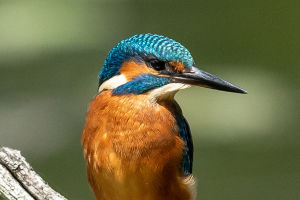The adult pelican is about 1.7 meters long with a wingspan of up to 3 meters, and its wings are strong and powerful, capable of sending its massive body into the sky with ease.
Weighing up to 13 kg, it is one of the largest birds in existence.
The beak is wide and straight, more than 30 cm long, with the tip of the upper beak bent downward and hooked.
The lower beak is divided into two branches, between which there is a huge and expandable skin throat capsule.
The skin capsule is formed by connecting the lower beak shell with the skin, which can be freely retracted.
The huge beak and throat capsule make the pelican appear top-heavy.
When pelicans walk on the ground they always waddle and stagger. This is because the pelican's large beak is very obtrusive.
Pelicans are sharp-eyed and good swimmers and flyers.
Even when flying high in the sky, fish roaming in the water cannot escape their eyes.
Occasionally, the pelican's feet do not come together in flight and it swings its paws in the air in a comical manner.
The pelican mainly inhabits lakes, rivers, coastal and swampy areas, deserted islands, lagoons, and occasionally ponds and mangroves.
Pelicans prefer to live in flocks.
Once a flock of pelicans has spotted a school of fish in the water, they will quickly follow it up and then arrange themselves in a semi-circle in order to encircle it.
They spread their wings and slap the water, forcing the fish into shallow water, and then open their large strainer-like beaks to catch large numbers of fish and shrimp.
The Australian pelican is the largest of the eight species of pelican found in the world.
The Australian pelican is a large shorebird, measuring 1.6 - 1.9 meters in length and weighing 4 - 6.8 kg, with some larger pelicans weighing up to 8.2 kg.
The Australian pelican has a very large wingspan, reaching 2.5 - 3.4 meters.
Females are slightly smaller than males.
Their plumage is white, with most of their wing feathers being black and black spots on their tails.
The face of the Australian pelican is white, with the back of the head and part of the neck being gray.
The eyes are brown and yellow. Their legs and feet are blue-gray with four webbed toes.
Australian pelicans have a large, light pink beak.
Their huge bill is the largest of any bird in the world, 49 cm long, and can hold 9 - 13 liters of water.
The tip of the giant bill has a small hook with serrated teeth used to catch slippery fish.
The mandibles consist of two thin, weak articulated bones with small pouches hanging from them.
It is hard to imagine a bird as large as a pelican flying, but they can do so easily because their skeleton is so light, making up only 10% of their total body weight.
The Australian pelican is a very buoyant bird and will not sink into the water.
However, pelicans don't have much waterproof oil on their feathers, so they can get wet and cold.


